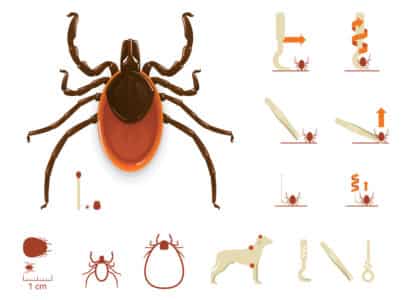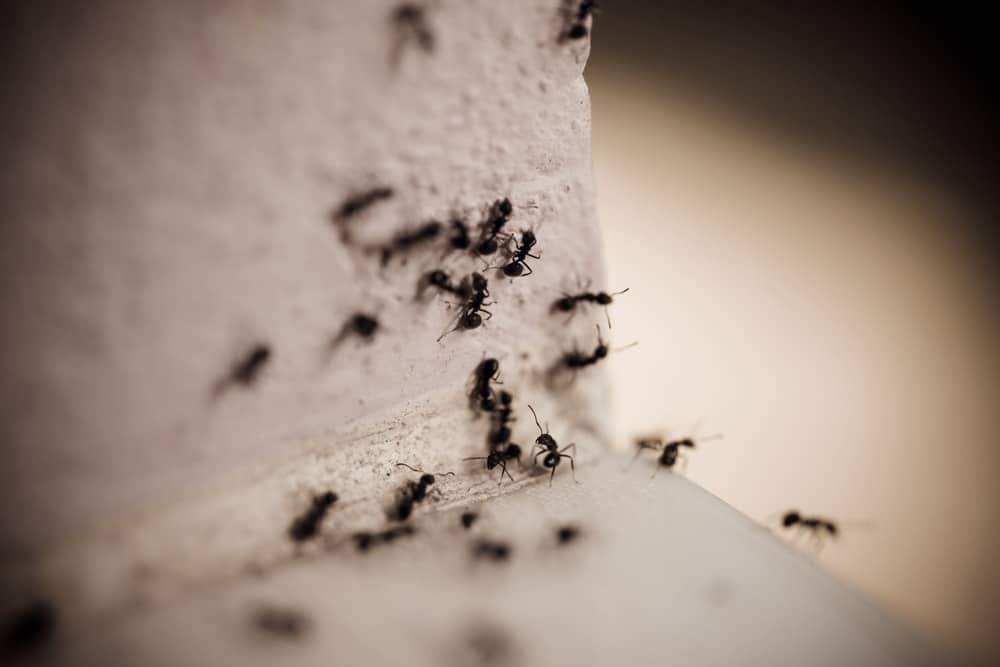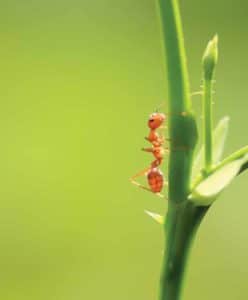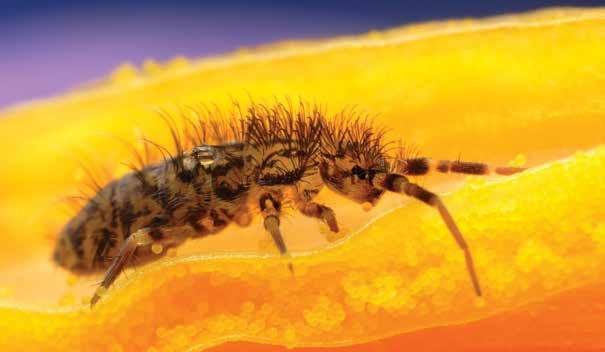How To Find and Remove a Tick

NOTTick season has arrived here per the Indiana State Department of Health. Last year, over 250 tick-borne cases were reported in Indiana… including Lyme disease, babesiosis, and ehrlichiosis.
How to Check for Ticks on You or Your Kids
You don’t have to be out in the deep brush to pick up ticks, they’re right in your backyard. Give us a call if you’d like to treat against ticks. Pets are highly susceptible to picking up a tick or two each season so its imperative that you keep an eye out for them. If you or your kids spend time outside, the CDC recommends that you check your body for ticks in the following places:
- In and around your hair and ears
- Under the arms, between the legs, in the backs of the knees, and around the waist
- Inside the belly button
If you check for ticks immediately, you can often just remove them because they’re still traveling and not actually embedded in your skin. Her’es a great video where tick expert Kateryn Rochon explains how to check:
How to Check for Ticks on Your Pets
Since pets are outside every day, you should get in the habit of checking your pet for ticks every day, too. Brush your fingers through their hair trying to feel any small bumps. Don’t forget to check behind their ears, around their eyelids, under the collar, under their armpits, around the tail, between their toes of their paws (Yea, dogs have toes!), and in the genital region.
How to Remove a Tick
Within hours of embedding their head into the skin, ticks begin to transmit any pathogens they’re carrying. That’s why it’s so important to not waste time and immediately remove any ticks. If they aren’t embedded, just pick them off and get rid of them. Since you picked up one, you should fully inspect yourself looking for others.
If you find a tick and it’s already feeding on you, you have to be extremely careful in their removal. Many people make the mistake of pulling them out, but the problem is that they have barbs like harpoons in their mouth. You pull off the body and the head stays… still infecting and still trying to feed.
There are quite a few methods of tick removal out on the web, but one that’s tried and true is to arm yourself with a tick removal tool. You can find one on Amazon for just a few bucks (buy it today so you have it when you need it!)

Tick removal tools are specially designed so that the claw grabs the head of the tick and they can be twisted out of the skin.
NOTE: Don’t use nail polish or petroleum jelly to try and make the tick detach. The CDC advises that this is folklore and you’re putting yourself in more danger of being infected. You want the tick out as quickly as possible.
After you remove the tick, clean the bite area and your hands with soap and water, rubbing alcohol, or iodine. Within days or as late as months later, you may experience symptoms of lyme disease – headaches, dizziness, stiffness, fever, chillse, fatigue, and body aches. If you see a rash around the bite area or have any of these symptoms, you should immediately make an appointment with a health professional.
Don’t forget to get rid of the tick! Don’t crush it, just flush it down the toilet.
Ants. ANTS. EVERYWHERE!

Fixing the issue early is key to enjoying an ant-free summer.
Birds are singing, flowers are blooming, and ants are everywhere. It must be spring time! There are a lot of things to enjoy about spring, but an overabundance of ants around your home is definitely not one of them. There are more than 50 different species of ants that regularly infest our homes, and they can be more than just a nuisance in our daily lives. Ants can destroy goods and property, and they can even pose a health risk by contaminating foods. Although it may not be possible to prevent ants from entering your home without professional help, you can reduce your chances of an infestation by following a few useful steps.
Ants invade your home in search of three things: food, water and harborage. Eliminate attractive food sources by immediately cleaning up food spills, not leaving dirty dishes in the sink and storing food items in the refrigerator or in sealed containers. Foraging ants often attack homes from colonies nesting outside. Minimizing resources around your yard is equally as important to slow the invasion.
Start by removing overgrown foliage, brush piles and excess fallen leaves to eliminate harborage or nesting sites on your property. Keep trees, shrubs and bushes trimmed back away from any structure to prevent ants from using branches as a sky bridge into your home. Keep waste containers clean and stored away from the home. This eliminates food sources that may attract hungry ants. Lastly, fix leaky pipes, AC drip lines or over-irrigated areas of the yard that could serve as moisture sources.
 Common pest entry points include poorly sealed doors, windows, and plumbing and utility penetrations. Many of these access points can be corrected by replacing worn out weather stripping on doors and windows, or by using an appropriate sealant to fill other gaps. Failing to identify or correctly seal all access points may still give ant’s free access to forage and nest inside your home.
Common pest entry points include poorly sealed doors, windows, and plumbing and utility penetrations. Many of these access points can be corrected by replacing worn out weather stripping on doors and windows, or by using an appropriate sealant to fill other gaps. Failing to identify or correctly seal all access points may still give ant’s free access to forage and nest inside your home.
Call us today to inspect your home, and to provide a detailed assessment of how we can protect your family from ants.
Spring into action against Springtails!

Your flower beds are not the only things to enjoy the higher temperatures and increased rainfall this time of year. Springtails also thrive in these warm, wet conditions. Springtails, fittingly named for their jumping behavior, are tiny insects that typically live in moist soil. They are present year round, but populations typically spike in early spring where they can overflow into your pool, patio or even into your home. Springtails do not bite or sting, and are therefore harmless to people. However, because Springtails jump when disturbed, they can easily be confused with fleas and can become a major nuisance pest indoors.
Springtails are very small, wingless insects about 1/16 of an inch long. They can vary in color from white to blue, grey or black depending on the species. Springtails prefer to live and breed in moist soil and leaf litter where they feed on decaying organic material, fungi, molds and algae. Their natural feeding behavior serves an important role in our ecosystem because springtails break down old plant material, helping in decomposition and returning important nutrients to the soil. Weather conditions play an important role in why springtails may move out of their typical soil environment. Springtails need just the right amount of moisture to survive. If their habitat becomes too dry or to wet, springtails will seek out more favorable conditions. This can lead to tremendous numbers of springtails moving onto higher ground, which can often include your home.
Once inside, Springtails continue their search for moisture where they commonly end up in rooms with high humidity such as bathrooms or damp basements. Although these areas may be humid, Springtails often die once inside the home unless a leaky pipe or similar moisture source is found. The key to avoiding an indoor invasion of Springtails is to focus on sealing the home and reducing moisture conditions.
Outside, check for windows and doors that may not close completely, or plumbing and utility penetrations that may need to be sealed. Also, eliminate breeding sites such as areas with excessive mulch or leaf litter. Pay special attention to low spots around your yard that may collect water, and avoid over watering shaded areas that may not dry as quickly. If a crawl space is present, ensure that the space has adequate ventilation. Inside the home, be sure that door sweeps provide a tight seal, and that leaky pipes or other sources of water leaks are corrected immediately. Potted plants can also serve as an indoor breeding site for Springtails. Therefore, avoid over watering plants to keep moisture levels low, and always inspect outdoor potted plants for signs of Springtails before bringing the plants inside.
Remember, the presence of Springtails can be an early warning sign of moisture issues that could attract pests and lead to costly water damage, so be sure to let us know if you have noticed Springtails in or around your home
No One Dreams of Having Brown Recluse Spiders for the Holidays… But…

As you prepare for holiday parties and visitors, issues with spiders and other pests are probably the last thing on your mind. However, winter is the perfect time for the development of infestations of spiders and other insects. When the outdoor temperatures drop, spiders seek warmth and protection by making their way into your home. It’s important for homeowners to be aware of where to look for spiders and how to protect themselves from spider bites. The brown recluse spider is common in many parts of the United States and poses a particular threat to families during the winter months. Find out how to recognize and protect yourself from this common spider below.
What is a Brown Recluse Spider?
The brown recluse is one of the most common types of spiders throughout many parts of the United States. It is also among the most feared spiders because of its poisonous bite that can be painful and damaging to the tissue of the body.
Image Credit: PestWorld
Brown recluse spiders have a unique appearance that makes them easy to differentiate from other types of spiders. As their name suggests, they are brown in color and feature a prominent violin-shaped mark on their back. Their name also gives away a key clue about their nature. Brown recluse spiders are generally very shy and will choose to remain hidden as much as possible. However, they lash out with a painful and destructive bite when they feel trapped or threatened in some manner, making them a huge safety concern for homeowners everywhere.
Are Brown Recluses Dangerous?
Brown recluse spiders inject a venom when they bite either humans or animals. This venom can cause many potentially serious health concerns. Each person reacts differently to a brown recluse bite. The severity of symptoms can vary depending on the age and health of the victim, the size of the spider, and the amount of venom that was injected with the bite. Physical symptoms of a brown recluse bite can include fever, chills, skin blisters, necrotizing of the skin around the bite, and other serious reactions. It’s easy to see why everyone wants to avoid being bitten by a brown recluse, and this includes the need to protect any household pets from being harmed by these spiders.
Favorite Places for Brown Recluses to Hide
As mentioned earlier, brown recluse spiders are shy by nature. They will usually choose dark and quiet areas within your home to take up residence and reproduce. It’s important that homeowners are aware of the most common locations for the development of spider infestations. Regularly investigate the following areas of your home for the presence of spiders.
- Attics – Attics are a prime real estate for brown recluse spiders. The perfect combination of warmth, darkness, and a crowded environment to hide in provides these spiders with a comfortable home.
- Basements – Depending on the type of basement you have, this may be another area of your home to keep an eye on. Many people tend to store unused clothing, toys, and random containers in their basement. Be aware that brown recluse spiders can quickly take up residence in these items.
- Closets – Clothing, shoes, and unused winter weather gear are the perfect hiding places for spiders. It’s a good idea to not leave items on the floor of your closet and to check the insides of shoes, hats, and gloves before wearing them. This is especially true if the item has not been worn for a long time.
- Garages – The garage is another area of the home where people tend to store boxes of items such as sporting goods and out-of-season clothing. This creates a cramped location for spiders to hide away undetected.
How to Keep Brown Recluse Spiders Out of Your Home
Now that you’re aware of some of the more common places for brown recluse spiders to hide in your home, you may be wondering how to keep them from coming inside in the first place. There are several steps you can take to lessen the chances of developing problems with brown recluse spiders. Consider the following tips.
- Declutter favorite hiding areas – Creating unfavorable living conditions is the best way to prevent infestations of brown recluse spiders. Decluttering any storage bins, boxes, clothing piles, seasonal decor, and even paperwork can prevent these spiders from having good places to hide and deter them from sticking around.
- Seal any cracks or holes in the perimeter of your home – While this step may not be able to prevent the entry of all spiders and insects, sealing off all small openings around the perimeter of your home will reduce the number of spiders that get inside.
- Eliminate outdoor hiding places – When you’re working to cut down on hiding places for brown recluses, don’t forget about common outdoor habitats. These shy spiders love to hide under wood piles, loose stones, or areas where a lot of yard debris accumulates.
- Use sticky traps in common hiding areas – Setting up a few non-toxic sticky traps in areas that spiders tend to favor can easily catch the few who do make it into your home, keeping them from being able to reproduce and create a problem.
Common Ways People Get Bitten by Brown Recluse Spiders
Most people get bitten by a brown recluse spider when they inadvertently disrupt its hiding place. Slipping on a pair of boots you haven’t worn since last winter without knowing a spider is inside can surprise both of you. The same applies to clothing such as gloves, hats, and jeans. If you’re moving boxes or stored items that may have spiders in them, wear thick gloves and long sleeves to protect yourself.
How to Identify and Treat a Spider Bite
Brown recluse bites do not always have the same appearance for all people. However, pay attention to any painful or itchy bites that don’t go away within a day or two. If the skin surrounding a bite becomes red, hot, inflamed, or begins to break down, seek medical help right away.
Where and When to Seek Medical Help for a Spider Bite
While brown recluse bites will not kill you, they can be painful and lead to significant scarring in some individuals. If you have a spider bite that is worsening, causing you discomfort, or resulting in an open wound that resists healing, you need to seek medical care. A family physician or an emergency room facility can analyze the bite and may be able to offer helpful suggestions to encourage healing and reduce scarring.
The holiday season is a time of joy and gathering together with loved ones. It’s not a time to be worried about being harmed by brown recluse spiders. With the help of the information above, you’ll be better equipped to locate and handle any issues with spiders that you may have this holiday season.
How Do Mice and Other Pests Get Into Your Home?

It’s the time of the year when critters are preparing for cold weather and finding places to nest for the winter. We’re already seeing an increase in reporting of mice and rats. Animals are relentless at finding ways to get into your home, so you may want to inspect your home before it gets too cold. In fact, according to PestWorld, 45% of all rodent infestations happen in the fall and winter!
Pests like mice are relentless in the fall and winter as they seek warmth and food. Mice are like mini-torpedoes, with incredibly strong jaws and a body that can fit through cracks a fraction of their size. These pests will find cracks in your foundation, walls, attics, and floors – especially near food – and chew until they can make it in and out. And within months, a couple mice can reproduce into hundreds of mice!
Pests cause structural damage inside your walls, attics, and crawl spaces as they build out their new home in yours. The best means of keeping them out is to inspect and remove any openings or things that attract them.
- Piping – if you have water pipes that run through crawl spaces, be sure you don’t have any leaks. Even the smallest drip can be a great water supply for a small rodent. Damp spots are magnets for insects as well.
- Foundation – be on the lookout for any holes or large cracks in your foundation. Small animals can get into those gaps and then chew their way through wood to get to warmth.
- Doors and windows – a loose door or window can provide enough of a gap for pests to squeeze through. Even a screen with a rip in it can attract unwanted pests.
- Chimney – since you haven’t used it in a while, have your chimney cleaned and inspected. Birds and other small animals may have created nests without you realizing it.
- Roof – broken shingles and cracked caulk are gaps where pests and insects can enter your attic.
- Crawl Spaces – try to ensure you have an access cover or door to stop your crawl space from becoming the local hotel for every pest in the neighborhood.
- Ventilation – vents sometimes settle and provide a cozy superhighway and nesting ground right in your home.
- Vegetation – outside of your home, it’s time to trim limbs and bushes that are touching your property. A great tree limb is a bridge for an animal to get safely in your attic or chimney. Cut them back a couple feet so that they can’t take the leap.
- Firewood – store your firewood as far away from your home as possible while still being convenient.
- Food – store food like cat and dog food in plastic containers that close tight. The scent of a free meal may be too good to pass up for a pest. And once they find a source, they’ll stay close to keep themselves fat and happy for the winter.
It’s not just a great idea to keep your home secure from pests, these are also ways that the cold air gets into your home and racks up your electric bill. Taking a few hours to check everything while the weather is nice can save you a few bucks a month on your utility bills as well!
If you hear odd noises in your home like scratching or chewing, you may already have someone setting up their little pet apartment. As well, you may see small droppings and mistake it for dirt. Keep alert to these as you may have an infestation already. Pests will do a great job of staying hidden during the daytime or when no one is home.
You can’t blame a family of pests for seeking shelter as the weather turns cold. And it’s not necessary to kill or poison these pests, they can be safely removed and relocated to a new home far away from yours. We can trap the animal and release it in an authorized catch and release location designated by the city or county.

